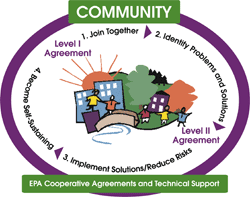Community Action for a Renewed Environment (CARE)
Healthy Air for Northeast Denver
Fall 2007

About CARE
Community Action for a Renewed Environment (CARE) is an EPA technical assistance and grant program that offers an innovative way for a community to organize and take action to reduce toxic pollution in the local environment.
Level I, Level II Grants
Awarded at two monetary levels, over two years, CARE grants help communities tackle their problems using a four-step process (see diagram below). Level I grants (up to $100,000) enable communities to progress through the first two steps, which are: 1) build a broad-based partnership and 2) identify a range of environmental problems and solutions. Level II grants (up to $300,000) fund the next two steps, which are: 3) take action to reduce risks and 4) become self-sustaining.

The Healthy Air for Northeast Denver partnership includes a team of community health workers, or promotoras, who educate primarily Spanish-speaking residents about indoor air hazards.
The goal of the Healthy Air for Northeast Denver (HAND) partnership is to improve environmental quality voluntarily and collaboratively, with a primary focus on air quality. The 20-square mile project area includes the northeast neighborhoods of Globeville, Elyria/Swansea, Cole, and Clayton, and part of Commerce City. Sunnyside, west of Interstate 25, is also included. Ninety-one percent of HAND neighborhood residents are people of color and 25 percent live in poverty. In the early 1960s, when the first Denver stretch of Interstate 70 was built, it bisected several of these neighborhoods and began increasing residents’ exposure to traffic-related air pollutants. Today, local businesses house, service, and operate nearly 11,000 diesel trucks. Additional impacts to air quality include a petroleum refinery, a bulk petroleum terminal, a coal-fired power plant, a furniture manufacturer, and many solvent-based industries.

Step 1: Joining Together
In August 2004, about 30 representatives of government agencies, nonprofit organizations, neighborhood associations, and local industry were convened by US EPA Region 8, which provided a third-party facilitator to help the group identify priorities. A multi-party team drafted an application for CARE funding, and in October 2005, Groundwork Denver, Inc. (GWD), on behalf of HAND, received a Level II grant. GWD manages the overall project and chairs the partnership with advice from a steering committee made up of workgroup leaders.
Step 2: Identifying Problems, Solutions
During 2004 and 2005, HAND partners decided to focus on outreach, education, and toxics reductions in the following areas: emissions from diesel and small stationary sources, indoor air, and land use. The group also formed teams to support the partnership with community involvement and data analysis.
Step 3: Implementing Solutions, Reducing Risks
- HAND conducted seven “Tools for Schools” audits to find indoor air quality problems and engaged with students in projects to address those problems.
- Students in 14 middle and elementary schools completed 19 additional environmental projects ranging from graffiti clean-up to tree planting and pollution research.
- A team of six “promotoras” (community health workers) visited 157 Spanish language-dominant homes to educate residents about indoor air hazards; 136 residents signed “Smoke-Free Home” pledges.
- HAND participated in five community events using the “Breathe Better Bus,” a 40-foot bus powered by compressed natural gas and outfitted with interactive learning stations which teach visitors about the importance of lung health in English and Spanish.
- HAND’s Data Analysis Team developed an interactive air quality presentation for the public based on the Denver Air Toxics Monitoring Report and Risk Assessment produced by the Colorado Department of Public Health and Environment.
- HAND partners mapped the location of 331 trucking businesses and 355 small businesses and hired a local diesel engine expert to reach out to these businesses about best management practices and pollution prevention.
- HAND is working with the Elyria/Swansea neighborhood to develop a small-area plan to guide land use and identify revitalization opportunities. Photovoice, an innovative technique wherein community residents use cameras to tell a story, was used to help Spanish speakers contribute to the plan.

Denver, CO
Step 4: Becoming Self-Sustaining
HAND successfully uses the CARE model as a catalyst to attract new partners and create new opportunities to improve northeast Denver’s environment by sharing leadership and resources. For example, GWD partnered with a neighborhood mentoring program to hire local youths to work on a wide range of environmental projects, including water quality outreach and lead poisoning prevention. HAND partnered with the National Civilian Community Corps to put 100 AmeriCorps youth to work on environmental service learning projects. The Denver Department of Environmental Health and GWD plan to pilot a climate change initiative in Sunnyside and a neighborhood outside the initial project area, Highland. GWD’s experience with HAND led to its building a partnership with Commerce City to identify sites for targeted brownfields assessment.
Partners
- American Lung Association of Colorado
- Civic Association of Clayton
- Colorado Department of Public Health and Environment
- Colorado Department of Transportation
- Colorado Motor Carriers Association
- Community Research Education and Awareness Results
- Cross Community Coalition
- Denver City Councilwoman Judy Montero
- Denver Department of Environmental Health
- Denver Department of Planning
- Elyria/Swansea Business Association
- FrontRange Earth Force
- Globeville Business Association
- Groundwork Denver, Inc.
- Highland United Neighbors, Inc.
- Northeast Denver Housing Center
- Regional Air Quality Council
- U.S. EPA Region 8
For Further Information
Please visit the CARE Web site for more information.
Deldi Reyes (reyes.deldi@epa.gov), U.S. EPA Project Lead
U.S. EPA
(202) 564-1465
Charlie Chase (charliechase@groundworkdenver.org), HAND Project Manager
Groundwork Denver, Inc.
(303) 455-5600 (office) / (720) 690-4341 (cell)
PDF Versions
- Healthy Air for Northeast Denver, Fall 2007 (PDF) (2 pp, 296K, About PDF)
